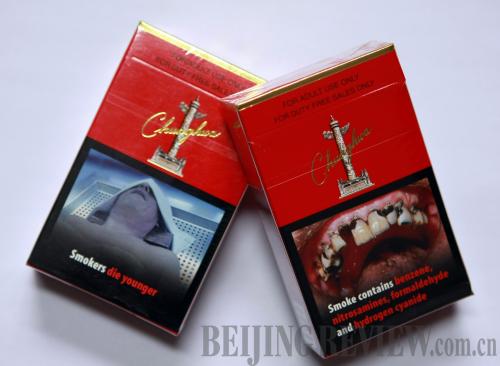|
 |
|
SMOKING KILLS: China requires warning labels to cover no less than 30 percent of cigarette packs, in efforts to fulfill its commitment to an international tobacco control treaty (JIANG XIAOYING) | China also considered establishing joint venture cigarette factories that produce foreign brand cigarettes. On September 4, 1986, Huamei Cigarettes Co. Ltd. was set up. Jointly established by Fujian Province-based Xiamen Cigarettes Factory and R.J. Reynolds Tobacco Co. from the United States, it was the first joint venture cigarette company on the Chinese mainland since 1949. With a total investment of $21 million (each party holding 50 percent), the term for cooperation was set at 18 years.
Within the 18-year joint venture period, Huamei produced 883,200 boxes of cigarettes ranging from Golden Bridge to Camel, paying taxes of 2.56 billion yuan ($374.82 million) and recording profits of 957 million yuan ($140.12 million).
After the cooperation contract expired in September 2004, the contract parties agreed to transfer their stakes in Huamei to Xiamen Cigarettes Factory. Huamei was later renamed Golden Bridge Production Center of Xiamen Cigarettes Factory.
During the Huamei joint venture timeframe, changes were made to the consignment system for foreign cigarettes. After China reformed its tax rate mechanism in 1994 and later reformed its foreign exchange rate mechanism, the consignment business of foreign cigarettes was almost at a standstill. The situation permit China to learn from international practice and permit the production of famous foreign brand cigarettes under the term "licensed production."
Licensed production allows for the production and sale of foreign brand cigarettes in China under certain stipulations. A trademark and technical guidance fee must be paid to the foreign companies in accordance with the actually produced volume. All products made in China, however, cannot be exported and cigarettes of the same brands are not allowed to be imported any more.
Since Huamei, no cigarette joint ventures have been approved in China. Instead, cooperation between Chinese and foreign tobacco companies is largely carried out under the framework of licensed production. Sales of cigarettes are still a government monopoly.
According to the STMB, since tobacco products are special commodities and harmful to human health, they cannot be produced and sold randomly. Hence China will not change its centralized and unified management policy toward the tobacco industry.
Active control
Although the tobacco industry has the potential to reap handsome fiscal revenue, the Chinese Government has never been hesitant toward tobacco control.
In 1986, China began requiring tobacco companies to note tar content on cigarette packages. Since then, the standard for tar content has been properly applied, with some companies even warning that "smoking is harmful to your health." In 1990, the China National Tobacco Corp. stipulated that cigarette companies must print health warnings on product packages, a requirement confirmed by Chinese Government legislation in 1991.
As people continue to develop a general understanding of the harmful effects of smoking, cigarette companies have taken steps to control tar content and the amount of nicotine in their products, steering them to safer levels.
In 2005, the Chinese Government required cigarette companies to note the carbon monoxide contents on cigarette cases.
As of January 1, 2009, to fulfill requirements set forth by the WHO Framework Convention on Tobacco Control, China requires warning labels to cover no less than 30 percent of cigarette packs.
Every year around World No Tobacco Day in May, the Chinese Government initiates large-scale tobacco control campaigns. The government also prohibits tobacco producers and sellers from launching advertisements that contain names and signs of tobacco companies as well as names and trademarks of tobacco products.
Some tobacco companies are taking alternative measures to gain publicity. Figures from the Chinese Association on Tobacco Control showed that from September to December 2009, 52 tobacco companies made donations to 79 public benefit, cultural and sports activities covering 40 cities and counties in 15 provinces, autonomous regions and municipalities to promote themselves, including donations made to the Hope primary schools.
On January 17, 2010, the association issued a petition to the country's top legislature calling for the amendment of laws and regulations on tobacco as soon as possible to prevent tobacco companies from covert publications. It also suggested a prohibition on tobacco advertising, donation and sponsorship of all forms.
Tobacco Figures
China is the largest tobacco producer in the world. During the past 10 years, its average annual production of leaf tobacco accounted for 35 percent of the world's total. Its production and sale volumes of cigarettes accounted for 32 percent of the world's total.
In 2009, the 21 leaf tobacco production areas in 132 counties (there are about 260 counties in China) planted 1.12 million hectares of roasted tobacco.
China has the largest smoking population in the world—350 million. Every year, 1 million Chinese die of tobacco-related diseases.
(Source: Chinese Association on Tobacco Control)
| 